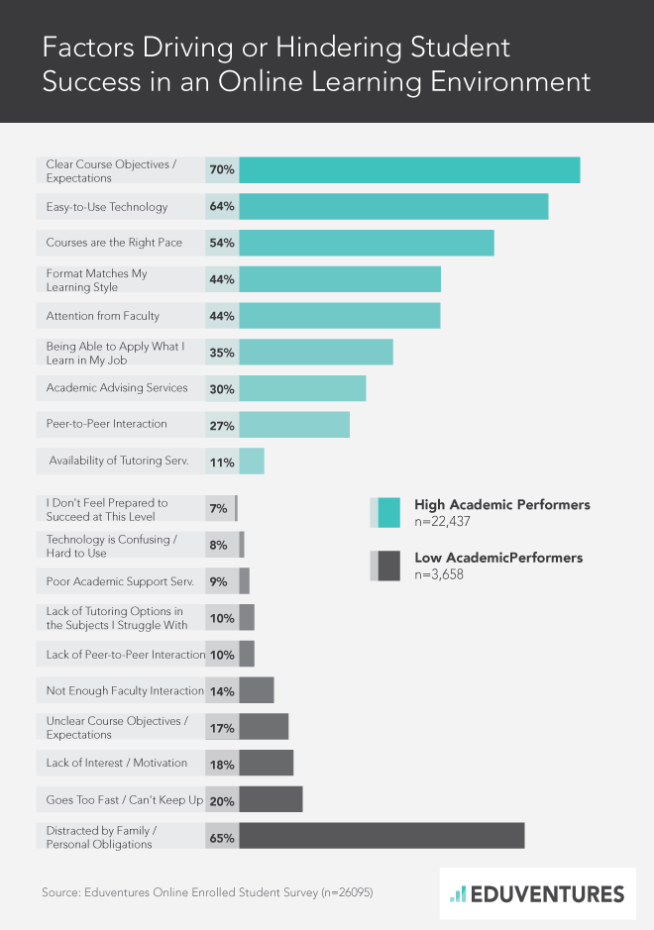Improving online student success can be overwhelming, but findings from a recent Eduventures study suggest that it is not as complicated as it seems. What really helps online students succeed is adherence to a couple basic of measures of quality that have always informed effective course design.
Insights on Online Student Performance
In the spring of 2015, Eduventures fielded the Eduventures’ 2015 Online Student Surveyof 28,000 students, primarily adult learners over the age of 25, who are currently pursuing a degree or certificate program online. One goal of this research was to help our clients better understand factors driving or hindering success in an online learning environment. As part of our survey, we asked respondents to assess their academic performance to date, with responses ranging from “great” to “very poor,” and to identify specific factors they say contribute to high or low performance. Here is what we found:- High performing students said the basis for their success is having clear course objectives and expectations at the outset and easy-to-use technology. These factors far outweighed others like faculty and peer interaction and even advising or tutoring services, which are valuable but of much lower importance in the minds of students.
- Poorly performing students said that, beyond the usual factors, such as personal distractions and lack of motivation, they struggle most with the pace of their courses, which many said move too quickly. While some personal touches would improve performance among this at-risk population, objectives and expectations rose to the top once again. A smaller, but significant, number also cited confusing or difficult to use technology as a barrier to their success.

Improve Student Success by Getting Back to Basics
To boost online student success, launch a “back to basics” campaign among key stakeholders involved in online learning. Include faculty, instructional designers, program leaders, vendors, and, of course, your students. Start this campaign by focusing on the following priorities:- Align your online courses with objective design standards to improve performance. Ensure all of your online courses pass through a rigorous peer review process. Enlist faculty, instructional designers, and course experts to carefully check for the presence of clear objectives and expectations and to weigh in on their effectiveness in guiding student learning. Focus also on improving the performance of existing courses through a post-design quality assurance process. As outlined in Eduventures’ online course review rubric, this process should assess how clearly objectives and expectations are stated at the outset of the course and how pervasive they remain throughout the learning experience. Findings should be quantified, shared with instructors, and continuously measured to ensure improvement over time.
- Optimize use of your learning management system (LMS) to enhance the student experience. Just as a live classroom should be easy to navigate, clean, and hospitable, so too should your LMS. This environment should prioritize student success above all else. Bring key stakeholders to the table to focus on the state of your LMS. Consider students’ satisfaction with the online learning experience and how well it is currently performing compared to alternative configurations or even other systems. Engage your product provider with your demands not only for improved system performance, but also for improved student performance. In our work helping clients with product review and contract negotiation, we often remind institutions that student success should drive vendor relationships. If your students are not succeeding, this may be due to the quality of the product and the level of service you are receiving from your vendors. Hold vendors to delivering in order to meet your stated needs.
- Find a new system, if needed. Most major LMSs have made student success more of a priority, and the possibilities to maximize their systems and partner with these companies in this effort are endless. Chances are, as you begin to dig deeper into the use of your LMS, you may find yourself looking over the fence at other options. The good news is that the market is brimming with new products and compelling alternatives. Do not be afraid to shop around and think outside the box. At a minimum, this evaluation of alternative products could force your existing vendor to provide enhanced support to better meet your needs. Eduventures’ upcoming report series on the evolving LMS landscape will cover a range of issues related to system selection and optimization, with student success front and center in our analysis.

